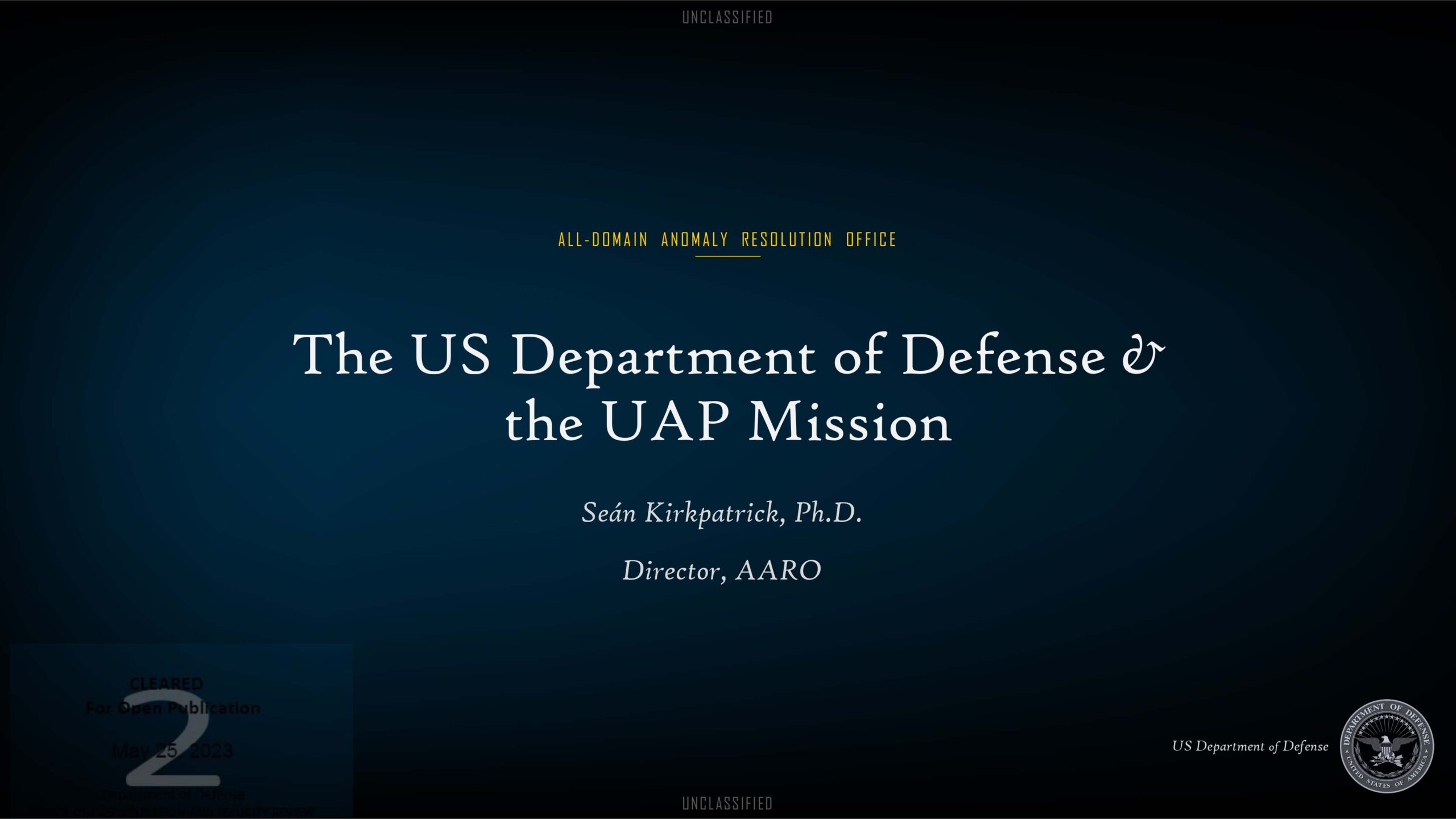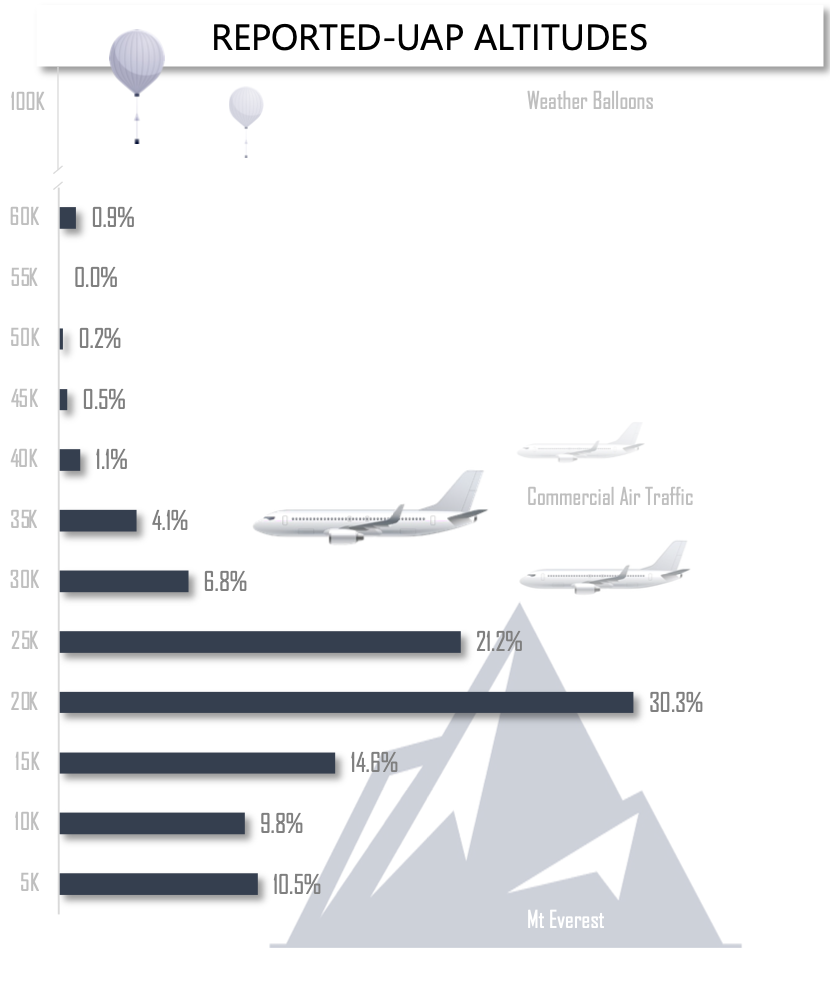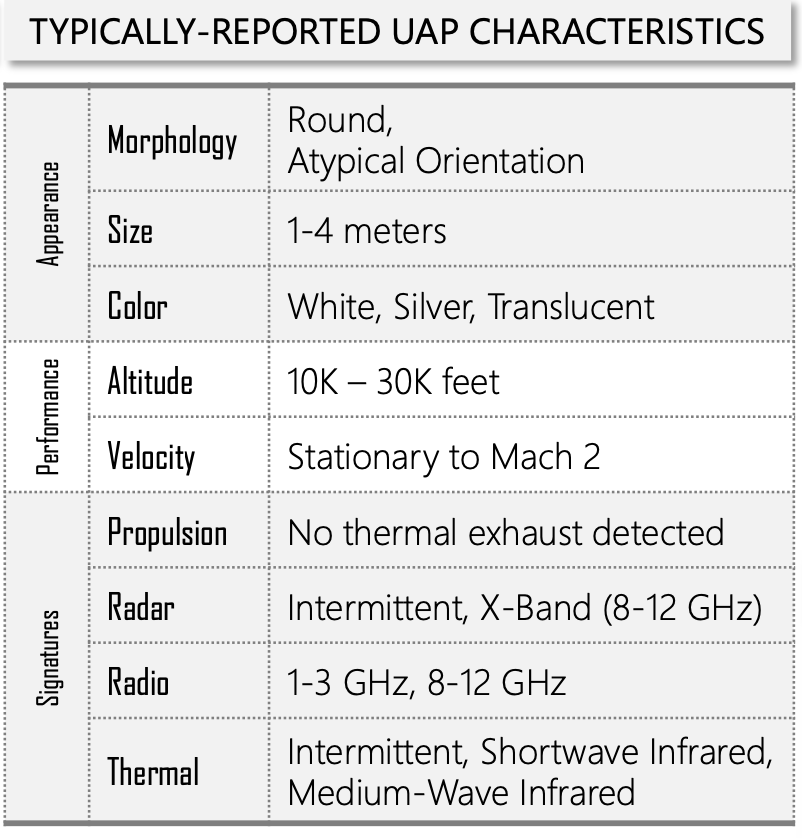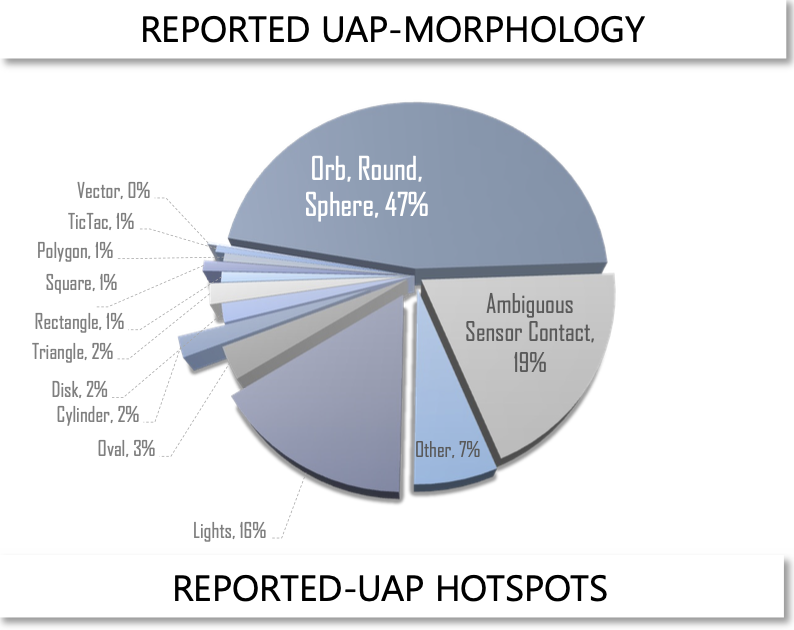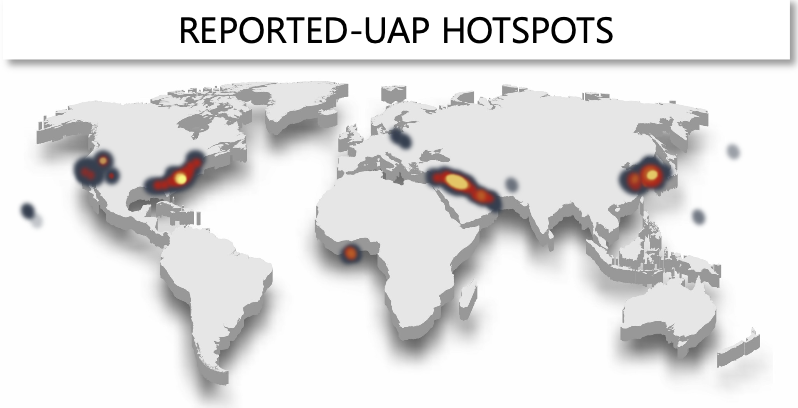Reports & Presentations
The following reports and presentations, which will be added to as more are released, represent official products of the US Department of Defense and the Office of the Director of National Intelligence (ODNI).
As agencies such as NASA (through its UAP Independent Study Team, or UAPIST) begin releasing their own official reports on UAP, those too will be added here.
All reports and presentations are listed in the chronological order of their release, and include the date of release, as well as the issuing office and agency that was involved in their preparation.
Preliminary Assessment: Unidentified Aerial Phenomena (Unclassified version)
Release Date: June 25, 2021
Issuing Office: The UAP Task Force (UAPTF), operating within the Office of Naval Intelligence (ONI), reporting to the Under Secretary of Defense for Intelligence & Security (USDI&S), and working under the direction of the Office of the Director of National Intelligence (ODNI)
This was the first major UAP report released publicly by the US Government in decades, and represented the culmination of the work of the UAPTF (which evolved into AOIMSG and then AARO, both of which seem to generally operate under the same organizational structure). Its issuance was mandated by the FY21 Intelligence Authorization Act (IAA).
The classified version of the report (heavily-redacted), originally made available to select members of Congress, was obtained through a FOIA request by The Black Vault and is available here.
Top Quotes
“Most of the UAP reported probably do represent physical objects given that a majority of UAP were registered across multiple sensors, to include radar, infrared, electro-optical, weapon seekers, and visual observation.” (page 3)
“In a limited number of incidents, UAP reportedly appeared to exhibit unusual flight characteristics.” (page 3)
“UAP clearly pose a safety of flight issue and may pose a challenge to U.S. national security.” (page 3)
“Most reports described UAP as objects that interrupted pre-planned training or other military activity.” (page 4)
“Narratives from aviators in the operational community and analysts from the military and IC describe disparagement associated with observing UAP, reporting it, or attempting to discuss it with colleagues. Although the effects of these stigmas have lessened as senior members of the scientific, policy, military, and intelligence communities engage on the topic seriously in public, reputational risk may keep many observers silent, complicating scientific pursuit of the topic.” (page 4)
“In 18 incidents, described in 21 reports, observers reported unusual UAP movement patterns or flight characteristics.
Some UAP appeared to remain stationary in winds aloft, move against the wind, maneuver abruptly, or move at considerable speed, without discernable means of propulsion. In a small number of cases, military aircraft systems processed radio frequency (RF) energy associated with UAP sightings.
The UAPTF holds a small amount of data that appear to show UAP demonstrating acceleration or a degree of signature management. Additional rigorous analysis are necessary by multiple teams or groups of technical experts to determine the nature and validity of these data. We are conducting further analysis to determine if breakthrough technologies were demonstrated.” (page 5)
“Although most of the UAP described in our dataset probably remain unidentified due to limited data or challenges to collection processing or analysis, we may require additional scientific knowledge to successfully collect on, analyze and characterize some of them. We would group such objects in this category pending scientific advances that allowed us to better understand them. The UAPTF intends to focus additional analysis on the small number of cases where a UAP appeared to display unusual flight characteristics or signature management.” (page 6)
“UAP pose a hazard to safety of flight and could pose a broader danger if some instances represent sophisticated collection against U.S. military activities by a foreign government or demonstrate a breakthrough aerospace technology by a potential adversary.” (page 6)
“We currently lack data to indicate any UAP are part of a foreign collection program or indicative of a major technological advancement by a potential adversary. We continue to monitor for evidence of such programs given the counter intelligence challenge they would pose, particularly as some UAP have been detected near military facilities or by aircraft carrying the USG’s most advanced sensor systems.” (page 6)
2022 Annual Report on Unidentified Aerial Phenomena (Unclassified Version)
Release Date: January 12, 2023
Issuing Office: The All-domain Anomaly Resolution Office (AARO), reporting to the Under Secretary of Defense for Intelligence & Security (USDI&S), and working under the direction of the Office of the Director of National Intelligence (ODNI)
While the name of the issuing office changed from UAPTF to AARO (with the unfortunately-named AOIMSG briefly existing in-between), this report really represents the second major annual report delivered publicly by the DoD’s UAP-focused office. Its issuance fell under the requirements of the FY22 National Defense Authorization Act (NDAA).
This report, at least the publicly-released version, ended up being a much briefer update than many members of the public, and Congress, had hoped for. While a classified version was also released to select members of Congress, who were briefed on its contents, this version has not yet seen the light of day, even in redacted form.
Top Quotes
“UAP events continue to occur in restricted or sensitive airspace, highlighting possible concerns for safety of flight or adversary collection activity. We continue to assess that this may result from a collection bias due to the number of active aircraft and sensors, combined with focused attention and guidance to report anomalies. AARO, in conjunction with NIM-Aviation and the IC, will continue to investigate any evidence of possible foreign government involvement in UAP events.” (page 2)
“Regarding review or analysis of UAP events, ODNI and AARO operate under the assumption that UAP reports are derived from the observer’s accurate recollection of the event and/or sensors that generally operate correctly and capture enough real data to allow initial assessments.” (page 3)
“Initial characterization [of UAP] does not mean positively resolved or unidentified. This initial characterization better enables AARO and ODNI to efficiently and effectively leverage resources against the remaining 171 uncharacterized and unattributed UAP reports. Some of these uncharacterized UAP appear to have demonstrated unusual flight characteristics or performance capabilities, and require further analysis.” (page 5)
“Regardless of the collection or reporting method, many reports lack enough detailed data to enable attribution of UAP with high certainty.” (page 5)
“UAP pose a safety of flight and collision hazard to air assets, potentially requiring aircraft operators to adjust flight patterns in response to their unauthorized presence in the airspace, operating outside of air traffic control standards and instruction.” (page 6)
“UAP continue to represent a hazard to flight safety and pose a possible adversary collection threat.” (page 7)
The US Department of Defense & the UAP Mission (Unclassified)
Release Date (original version): April 19, 2023
Release Date (updated version with revised data): May 31, 2023
Issuing Office: The All-domain Anomaly Resolution Office (AARO), reporting to the Under Secretary of Defense for Intelligence & Security (USDI&S), and working under the direction of the Office of the Director of National Intelligence (ODNI)
Dr. Sean Kirkpatrick originally presented this report publicly at the April 19, 2023 Senate UAP hearing held by the Senate Armed Services Committee, Subcommittee on Emerging Threats and Capabilities, which was chaired by Senator Kirsten Gillibrand (D-NY).
Kirkpatrick provided an updated version of the report reflecting current data at NASA’s UAPIST public meeting on May 31, 2023, and a file of this version was released by NASA on their primary UAPIST site.
This report, and specifically its slide titled “UAP Reporting Trends: 1996-2023,” amounted to a significant release of previously-classified UAP data. This slide includes the following sections:
- Reported-UAP Altitudes
- Typically-Reported UAP Characteristics
- Reported UAP-Morphology
- Reported UAP Hotspots
All of this information was classified up until the release of this presentation, and the cover bears the subtle marking in the lower left-hand corner noting that it was “CLEARED For Open Publication May 25, 2023” (just days before the NASA meeting).
Report Highlights
The “Reported-UAP Altitudes” diagram makes clear that AARO is not receiving reports from the upper-atmosphere or from space (something Kirkpatrick has noted), and it is generally presumed that this is not because of a lack UAP being observed at these altitudes, rather, AARO is simply not receiving such reports by agencies who would likely be collecting them (e.g. the US Air Force and US Space Force).
The “Typically-Reported UAP Characteristics” table seems to specifically exclude the most interesting, highly-anomalous outliers among UAP reports (which are known to be less typical, but still very real, as acknowledged by officials in their hearing testimony, and in official UAP reports).
“Typically-Reported UAP Characteristics” does confirm very interesting UAP report details, such as these objects being observed hovering, and also moving at speeds up to (at least) Mach 2, all while exhibiting no signs of thermal exhaust (totally atypical for most aircraft capable of such speeds).
Additionally, radio emissions are sometimes detected that appear to be transmitted by UAP.
We also see that many UAP are relatively small at 1-4 meters in diameter (the larger end of this correlating with the estimated sizes provided by officials for the three UAP that were shot down over North America in February 2023).
The “Reported UAP-Morphology” pie chart indicates that the largest number of UAP are “Orb, Round, Sphere” in shape, which correlates directly to the largest single category of UAP shapes reported in the 1949 Project SIGN report.
A number of other shapes are common to both public UAP reports from the past 75 years, as well as Project SIGN’s shape chart, including Disk, Oval, Cylinder, and Square.
Almost all UAP (at least those whose shapes were clearly made out by observers) would seem to fall under the general descriptions of “spheroids,” “discoids,” “ellipsoids,” “cylinders,” and “polygons/polyhedra.” In other words, very simple geometric objects, quite unlike typical aircraft which are capable of hovering in high winds, traveling at up to Mach 2 and beyond, etc.
The “Reported-UAP Hotspots” diagram, by Kirkpatrick’s admission, correlates predominantly with where the US military operates regularly (training areas, theaters of combat and defensive operations, etc.) It does, however, clearly indicate that UAP sightings are global in nature.



